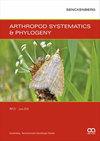New fossil stoneflies (Plecoptera: Arctoperlaria) from Australia testify ancient dispersal across Pangea
IF 1.8
2区 农林科学
Q2 ENTOMOLOGY
引用次数: 0
Abstract
The stonefly suborders Arctoperlaria and Antarctoperlaria reflect the current division of the diversity of this insect order between the Northern and Southern Hemispheres. However, there are several exceptions to this pattern, the most notable being the family Notonemouridae, which is phylogenetically deeply subordinate within the northern Arctoperlaria, but distributed in South Africa, South America, and Australia. Various hypotheses have been proposed regarding the circumstances of their dispersal to the south. Some estimated their origin as relatively recent, with long-distance dispersal to the southern continents in the Late Cretaceous or early Paleogene. On the other hand, fossils of Notonemouridae have been dated to the Middle Jurassic, proving the lineage is very ancient. However, all known notonemourid fossils originate from Asia and the timing of their dispersal to the south cannot be precisely estimated. Here we report new fossil stoneflies from the Late Jurassic Talbragar Fish Beds, Australia, described as Talbragaria australis gen. et sp. nov. and attributed to Notonemouridae. This finding represents the first fossil evidence of the northern suborder Arctoperlaria in the Southern Hemisphere, and confirms the north-to-south dispersal of Notonemouridae across Pangea prior to the continental break-up.澳大利亚新发现的石蝇化石(翅目:石蝇亚目)证明古代遍布泛大陆
石蝇亚目(Arctoperlaria)和南极石蝇亚目(Antarctoperlaria)反映了目前石蝇亚目在北半球和南半球的多样性划分。然而,这种模式也有一些例外,最值得注意的是Notonemouridae科,它在系统发育上在北部大针叶虫属中处于从属地位,但分布在南非、南美洲和澳大利亚。关于它们向南迁徙的情况,人们提出了各种各样的假设。一些人估计它们的起源相对较晚,在白垩纪晚期或古近纪早期就远距离扩散到南部大陆。另一方面,Notonemouridae的化石可以追溯到中侏罗世,证明了这个谱系非常古老。然而,所有已知的notonemouid化石都起源于亚洲,它们向南方扩散的时间无法精确估计。本文报道了澳大利亚晚侏罗世Talbragar鱼床的新石蝇化石,描述为Talbragaria australis gen. et sp. 11 .,归属于Notonemouridae。这一发现代表了南半球北部亚目Arctoperlaria的第一个化石证据,并证实了Notonemouridae在大陆分裂之前在整个泛大陆从北向南扩散。
本文章由计算机程序翻译,如有差异,请以英文原文为准。
求助全文
约1分钟内获得全文
求助全文
来源期刊

Arthropod Systematics & Phylogeny
Agricultural and Biological Sciences-Insect Science
CiteScore
2.50
自引率
5.60%
发文量
26
审稿时长
12 weeks
期刊介绍:
Arthropod Systematics & Phylogeny releases three times per year. Research fields covered are the taxonomy, morphology/anatomy, phylogeny (molecular or morphology-based), historical biogeography and palaeontology of arthropod taxa.
Arthropod Systematics & Phylogeny is the successor of Entomologische Abhandlungen, formerly published by the Museum of Zoology Dresden, Germany.
 求助内容:
求助内容: 应助结果提醒方式:
应助结果提醒方式:


